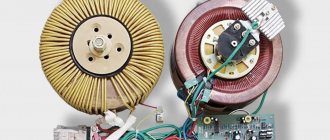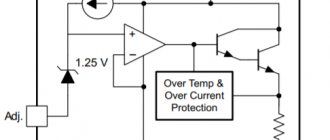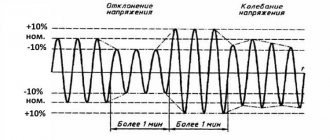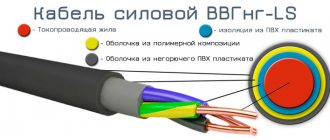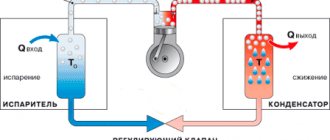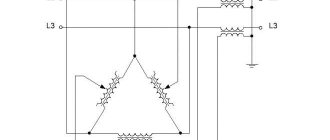Compensation serial
The compensating series regulator has feedback. In it, the output voltage is compared with a standard. The difference between them is needed to create a signal to the device that controls the voltage.
A certain amount of output voltage is removed from the resistance, which is compared with the main value of the zener diode. This difference is fed to the amplifier and applied to the transistor.
Stable operation is created by a phase shift. Since part of the output voltage is supplied to the amplifier, it shifts the phase by an angle of 180 degrees. A transistor connected like an amplifier does not shift the phases, and the loop shift is 180 degrees.
Pulse
Electric current, which has unstable properties, is supplied through short pulses to a stabilizer storage device, which is a capacitor or coil.
The accumulated energy is then released to the consumer with other properties. There are two ways to stabilize:
- Pulse length control.
- Compare the output voltage with the lowest value.
A switching regulator can vary the voltage with different results. They are divided into types:
- Inverting.
- Up-down.
- Promoting.
- Downward.
Advantages:
Low energy loss.
Flaws:
Interference in the form of pulses at the output.
DC Stabilizers
DC power requires equalization when the input voltage is below or above the permissible limit. When current flows through the stabilizer, it is leveled to the required value. Also, the stabilizer circuit can be made with a change in power polarity.
Linear
Such a device is a divider that receives an unstable voltage, and at its output the voltage is equalized and has the necessary properties. Its operating principle is to constantly change the resistance value to create a balanced power supply at the output.
Advantages:
- There is no interference during operation.
- A simple device with a small number of parts.
Flaws:
- If there is a significant difference between the output and input power, the linear stabilizer shows low efficiency, since a significant part of the produced power turns into heat and is dispersed across the resistance.
Parametric
This design of the device with a control element connected in parallel with the load is made using semiconductor and gas-discharge zener diodes.
The zener diode carries a current that is ten times higher than the current through the resistor. Therefore, such a circuit is suitable for stabilizing power only in low-power devices. Most often it is used as an integral component of current converters with a complex design.
Consistent
The operation of the device is visible in the diagram shown.
This circuit connects two components:
- Bipolar transistor that increases current. It is an emitter follower.
- Parametric stabilizer discussed above.
The output voltage does not depend on the current passing through the zener diode. However, it depends on the type of semiconductor substance. Due to the relative independence of these quantities, the output voltage is stable.
As the voltage flows through the transistor, the voltage at the output of the device increases. When using one transistor, the voltage may not satisfy the consumer. In this case, a device is made of several transistors to increase the current to the required value.
Series voltage regulator on a bipolar transistor
A series voltage regulator on a bipolar transistor is essentially a parallel parametric stabilizer on a zener diode connected to the input of an emitter follower.
Its output voltage is less than the stabilization voltage of the zener diode due to the voltage drop at the base-emitter junction of the transistor (for silicon transistors - about 0.6 volts, for germanium transistors - about 0.25 volts), which must be taken into account when choosing a zener diode. An emitter follower (also known as a current amplifier) allows you to increase the maximum current of the voltage stabilizer compared to a parallel parametric stabilizer on a zener diode by β (h21e) times (where β (h21e) is the current gain of a given transistor, the smallest value is taken).
Circuit of a series stabilizer based on a bipolar transistor:
Since this stabilizer consists of two parts - a reference voltage source (also known as a parallel parametric stabilizer on a zener diode) and a current amplifier on a transistor (also known as an emitter follower), the calculation of such a stabilizer is carried out similarly to the above example. The only difference: - for example we need to get a load current of 50 mA, then we select a transistor with a gain β (h21e) of at least 10 (β (h21e) = Iload/Ist = 50/5 = 10 - we calculate the power of the ballast resistor using the formula: Рres = Upad * (Ist +Iload)
The load current can be increased several times more if you use a circuit with a composite transistor (two transistors connected according to a Darlington or Sziklai circuit):
That's basically it.
Voltage stabilization based on thyristors and triacs
The active penetration of semiconductor components into electrical engineering is also reflected in the issue of stabilizing electrical energy. In the late 1970s, the development of voltage stabilizers began, operating on the basis of thyristors - semiconductor devices that have two states: “closed” with low conductivity and “open” with high conductivity.
Typically, thyristors are used as power switches in various electronic devices, such as motor speed switches, timers, dimmers, etc. Note that thyristors, depending on their design, can conduct current in one direction or in two (devices of the second type are called triacs).
Thyristor and triac voltage stabilizers are similar in principle to relay ones and differ only in that the switching of the autotransformer windings is performed not by relay units, but by electronic ones, consisting of thyristors or triacs. The use of such blocks allows you to regulate the voltage much faster than using classic electromechanical relays. Other advantages of this technology: absolutely silent operation and the absence of maintenance parts.
Today, triac and thyristor stabilizers are among the most common and popular, which, however, does not negate their main drawback - stepwise voltage regulation (similar to relay models).
More details about thyristor and triac stabilizers are described in the article “Electronic voltage stabilizers.”
Features of connecting the Resanta 10000 stabilizer
Before proceeding with installation, make sure that all operating conditions of this device are taken into account. So, there are restrictions on the temperature at which the device is allowed to operate: from +5 to +40 degrees Celsius. The humidity indicator should not be more than 80%.
It is important that the device has access to air. For this purpose, be sure to leave free space around it (5–10 cm)
If this is a floor-standing model, it should be placed at a distance of 50 cm from the wall. This rule is also relevant for any flammable objects that will stand next to the stabilizer. The sun's rays should not fall on the unit. The stabilizer must be grounded.
Let's look at the connection itself. Resanta 10000 has 5 terminals. Two are designated “L” - phases, the other two “N” - neutral wires. The fifth is allocated for grounding.
First of all, the device is grounded. Next, connect the “input”, with the phase connected to the “L” terminal. The neutral wire is connected to the neutral terminal.
Next, the equipment is turned on and the presence of voltage at the output is checked. After this, the unit turns off. If there is voltage at the output, the output cables are connected according to the same principle as the incoming ones.
If there is no output voltage, then you need to check whether the input wires are connected correctly.
AC voltage stabilizers
Such devices are designed to equalize alternating voltage regardless of its input parameters. The output voltage must be a perfect sine wave, regardless of input power defects. There are several types of stabilizers
Drives
These are stabilizers that accumulate energy from the input source, and then the energy is created again, but with constant parameters.
Engine generator
The operating principle of this type of voltage stabilizer is to change electrical energy into a kinetic form using an electric motor. Next, the generator again makes the opposite change, this time with constant parameters.
The main component of the system is a flywheel that stores energy and equalizes voltage. It is connected to the moving elements of the generator and engine, has a large mass and inertia, which maintains performance. Since the speed of the flywheel is constant, the voltage will also be constant, even with small voltage changes at the input.
Ferroresonant
The device consists of:
- Capacitor.
- Coil with an unsaturated core.
- Saturated core inductor.
A constant voltage is applied to the coil with a saturated core, and does not depend on the current, so you can select the data of the second coil and capacitance to stabilize the power within the required limits.
The operation of such a device is compared to a swing. It is difficult to stop them immediately, or to increase the swing speed. The swing also does not need to be constantly pushed, as inertia does its job. Therefore, there may be significant drops and power cuts.
Inverter
The circuit diagram of such a device consists of:
- Voltage transformer.
- Microcontroller.
- Capacity.
- Rectifier with power regulator.
- Entry filters.
The principle of operation of the inverter stabilizer is based on the occurrence of 2 processes:
- First, the input AC voltage changes to DC as it passes through the rectifier and corrector. In this case, electricity is accumulated in containers.
- Next, the DC voltage changes to AC at the output. From the tank, the current flows to the inverter, which transforms the current into alternating current with constant data.
Examples of application of the LM338 stabilizer (connection circuits)
The following examples will show you some very interesting and useful power circuits built using the LM338.
Simple regulated power supply on LM338
This diagram is a typical LM338 harness connection. The power supply circuit provides an adjustable output voltage from 1.25 to the maximum supplied input voltage, which should not exceed 35 volts.
Variable resistor R1 is used to smoothly regulate the output voltage.
Simple 5 Amp Regulated Power Supply
This circuit produces an output voltage that can be equal to the input voltage, but the current varies well and cannot exceed 5 amperes. Resistor R1 is precisely selected to maintain a safe 5 amp limiting current limit that can be drawn from the circuit.
Regulated 15 amp power supply
As mentioned earlier, the LM338 microcircuit alone can handle only 5A maximum, however, if it is necessary to obtain a higher output current, in the region of 15 amperes, then the connection diagram can be modified as follows:
In this case, three LM338 are used to provide high current load with the ability to regulate the output voltage.
Variable resistor R8 is designed for smooth adjustment of the output voltage
Digitally controlled power supply
In the previous power supply circuit, a variable resistor was used to regulate the voltage. The circuit below allows you to obtain the required output voltage levels using a digital signal supplied to the bases of the transistors.
The value of each resistance in the transistor collector circuit is selected in accordance with the required output voltage.
Lighting controller circuit
In addition to power supply, the LM338 IC can also be used as a light controller. The circuit shows a very simple design where a phototransistor replaces a resistor, which is used as a component to regulate the output voltage.
The lamp, the illumination of which must be kept at a stable level, is powered by the output of LM338. Its light falls on the phototransistor. When the illumination increases, the resistance of the photoresistor drops and the output voltage decreases, and this in turn reduces the brightness of the lamp, maintaining it at a stable level.
12V charger for LM338
The following circuit can be used to charge 12 volt lead acid batteries. Resistor R* can be used to set the required charging current for a specific battery.
By selecting resistance R2, you can adjust the required output voltage in accordance with the type of battery.
Smooth switching circuit (soft start) of the power supply
Some sensitive electronic circuits require soft power switching. Adding capacitor C2 to the circuit makes it possible to smoothly increase the output voltage to the set maximum level.
The stabilizer is assembled in a box-shaped housing
Case size 65x95x150 mm. The rear wall is the VT1 radiator, mounted on the chassis without insulating gaskets and determining the height of the case. The length depends on the used transformer and capacitors C1, NW Resistor R7 and the output terminals are located on the front wall. Housing material: galvanized steel.
There are no special requirements for details . The author's version uses available parts. Resistance R1 is wound with a manganin wire with a diameter of 0.5 mm, R2, R4, R5, R6 of type MLT-05, R3 - MLT1, R7 - SP 1-1. Capacitors C1, SZ type K50-12, C2 - K50-6. Radiator VT1 is cast - from the frame scan output stage of the ULPTsTI-59 TV.
Transistors VT2, VT3 are silicon, since germanium ones have a significant initial collector current, which impairs the performance of the stabilizer. Diode assembly - KTs402, switch SA1 type TP-1-2, transformer - 50 W, providing a voltage of 15V on the secondary winding at a current of 1.5A. Relay – RES6 (RF0452103).
Do LED bulbs need to be recycled?
LEDs that have lost their consumer properties are classified as waste of the fourth hazard class, that is, they are considered low-hazard. Materials used during the production stage can have a negative impact on the environment and must be recycled.
Hazard class, waste composition and FKKO code
LED lamps are waste of hazard class IV. Enterprises engaged in the production of lighting equipment are required to carry out their certification. This is described in detail in Russian Government Decree No. 712, issued on September 16, 2013.
Additional information: According to the Federal Classification of Municipal Waste (FKKO), LEDs are designated with the code 4 82 415 01 52 4.
Any LED lamp is multi-component. It consists of:
- base elements;
- aluminum body parts;
- polycarbonate;
- plastic.
All these components must be recycled or used in secondary production after recycling. No chemicals are used in the disposal or recycling process. Sorting is carried out without the use of personal protective equipment.
What the law says, Rospotrebnadzor requirements
LED lighting devices are manufactured in Russia according to GOST R 54815-2011/1EC/PAS 62612/2009. Often people who use such lamps at home throw them into ordinary garbage containers, which is contrary to the requirements of Rospotrebnadzor.
Before recycling LED lamps, the structure must be disassembled into individual elements and sorted by materials. The rest is taken care of by special processing enterprises.
Administrative responsibility for individual entrepreneurs and organizations
If waste LED lighting devices do not have waste certificates for products of the fourth hazard class, the enterprise bears administrative responsibility. According to the current regulatory framework, the violator is obliged to pay penalties in the amount of up to 250 thousand rubles. In addition, organizations can issue an administrative order to suspend activities for up to three months.
Schemes of 3-phase loads through 1-phase stabilizers
Devices used in everyday life consume less energy than industrial designs. Therefore, for normal network properties, you can use three voltage stabilizers of equal characteristics that correspond to the load for a 1-phase line.
If they use zero separation, then the following scheme is suitable for their installation:
In this diagram, for clarity, the PE protection wire bus is not indicated, and the connection of the stabilizers to it is made in a simplified manner.
The working neutral wire, after the protections located in the switchboard of the house, is divided into the output terminals of each stabilizer. Its bus is created by connecting the output terminals of all three devices in parallel. The zeros to all loads are approached by wire cores from this bus.
The phase terminal, which is included in each stabilizer, is connected to its terminals of the protective device, the output terminal with a group of circuit breakers that supply power to consumers.
If you combine working outgoing and incoming zeros, this makes the circuit simpler. But for some models, this method disrupts some control algorithms in the event of an accident. Therefore, manufacturers carry out this separation.
The diagram shows the connection of similar stabilizers to 3-phase loads.
All diagrams are shown to familiarize yourself with the principle of operation of voltage stabilizers. Therefore, the diagram does not depict switching devices, distribution boxes and other devices.
Connecting the stabilizer to the network
Watch this video on YouTube
Comparison of the main parameters and characteristics of modern C
The table will allow you to evaluate all the advantages and disadvantages and visually familiarize yourself with the parameters and characteristics of voltage stabilizers offered on the market.
| Model | PECAHTAACH-5000/1-C | IEK Prime 5 kVA | Centurion SM 5000 Line-C | Calm IS5000 |
| type | Relay | Triac | Electromechanical | Inverter |
| Power, Va | 5000 | 5000 | 5000 | 5000 |
| Efficiency, % | 97% | 95% | 96% | 97% |
| Performance, ms | from 20-35 | no more than 50 | response 200ms | 0 |
| Accuracy, % | 8 | 4 | 3 | 2 |
| operating voltage range, Volt | 140-260 | 90-270 | 140-270 | 90-310 |
| Cost, US dollars | 95 | 295 | 140 | 460 |
The simplest do-it-yourself voltage stabilizer
Let's look at how you can make your own 220-volt stabilizer with your own hands, having a few simple parts on hand. If the voltage in your electrical network is significantly reduced, then such a device will come in handy. To make it, you will need a ready-made transformer and a few simple parts. It is better to take note of such an example of a device, since it turns out to be a good device with sufficient power, for example, for a microwave.
For refrigerators and various other household devices, a decrease in network voltage is very harmful, more than an increase. If you increase the network voltage using an autotransformer, then while the network voltage decreases, the voltage at the device output will be normal. And if the voltage in the network becomes normal, then at the output we will get an increased voltage value. For example, let’s take a 24 V transformer. With a line voltage of 190 V, the output of the device will be 210 V; with a network value of 220 V, the output will be 244 V. This is quite acceptable and normal for the operation of household devices.
For manufacturing we need the main part - this is a simple transformer, but not an electronic one. You can find it ready-made, or you can change the data on an existing transformer, for example, from a broken TV. We will connect the transformer according to the autotransformer circuit. The output voltage will be approximately 11% higher than the mains voltage.
In this case, you need to be careful, since during a significant voltage drop in the network upward, the output of the device will produce a voltage that significantly exceeds the permissible value. The autotransformer will add only 11% to the line voltage
This means that the power of the autotransformer is also taken at 11% of the consumer’s power. For example, the power of a microwave oven is 700 W, which means we take a transformer of 80 W. But it’s better to take power with a reserve
The autotransformer will add only 11% to the line voltage. This means that the power of the autotransformer is also taken at 11% of the consumer’s power. For example, the power of a microwave oven is 700 W, which means we take a transformer of 80 W. But it is better to take power with a reserve.
The SA1 regulator makes it possible, if necessary, to connect the consumer load without an autotransformer. Of course, this is not a full-fledged stabilizer, but its production does not require large investments and a lot of time.
Homemade voltage stabilizer
Watch this video on YouTube
Setup and repair
Nobody repairs microcircuit stabilizers for the reason that it is hardly technically feasible, and the parts themselves cost mere pennies. Such a device does not need to be configured, because it is initially created for one specific voltage.
Power supplies and various voltage converters are quite repairable. Their cost can range from a few to thousands of dollars; for obvious reasons, only expensive models are restored.
LATR is not the cheapest device, but its design is quite simple. Its repair consists mostly of restoring burnt contacts and tightening various fasteners. In rare cases, if the LATR still manages to burn out, then its winding will have to be rewound.
There is a wide selection of adjustable voltage stabilizers. Some are bulky and handle loads of hundreds of watts. Others are no larger than 5 mm in size and easily fit into smartphones. Understanding where, how and what stabilizer to use allows you to use them as efficiently as possible.
Characteristics
A typical integrated stabilizer circuit consists of the following elements:
- reference voltage source;
- error amplifier;
- adjustment elements connected between the source and the load;
- circuit for turning off the device when a signal is supplied from the outside;
- transistor for protection against short circuit or overload.
Integrated stabilizer chips are functionally complete devices and have only three external pins: input, output and ground. These microcircuits are manufactured for fixed voltage values from 5 to 24 V and loads up to 1 A.
Stabilization devices on the IC are provided with built-in circuits that limit the output current, as well as an overload protection circuit for temperature.
Series regulator
This is a stabilizer installed in series with respect to the load. The series regulator consists of a zener diode (VR1), a current limiting resistance (R1), and a load resistance (RL).
The zener diode and the current limiting resistor are connected in series to form a voltage divider. The base of the transistor is connected to the voltage divider. The emitter-collector transistor circuit is connected in series with the load resistance.
Diagram of a series stabilizer connected to a bridge rectifier
Since the transistor is in a series regulator, the voltage acting on the base of the transistor is equal to the voltage drop in the zener diode. This potential is positive relative to the emitter of the transistor. Since the zener diode maintains the voltage drop at a constant level, the potential acting on the base of the transistor will remain constant.
A series regulator maintains a constant level of voltage applied to the load by varying the amount of voltage drop across the transistor. An increase in current through the load can be caused either by an increase in the power supply voltage or by a decrease in load resistance. As the current increases, the voltage drop across the load also increases. As a result, the voltage applied to the emitter of the transistor increases, making it more positive. This means that the electrical potential difference between the emitter and base becomes smaller, so the internal resistance of the transistor increases.
Relay voltage stabilization technology
The electromechanical relay, which appeared back in the 19th century, is probably the most common element in automation. In our country, it was first used in industry to control technological processes, and then became part of various household appliances. The development in the USSR of voltage stabilizers operating on the basis of a relay element and appropriately called “relay” dates back to the 1970s.
The main elements of a typical relay stabilizer are an autotransformer, an electronic control board and a power relay unit, each of which is essentially an automatic switch that connects or disconnects an electrical circuit under external influence or when certain parameters are reached.
During operation of the relay stabilizer, the control board constantly monitors the input voltage and, if it deviates from the nominal values, sends a signal to the relay unit. The subsequent closing (opening) of a certain relay switches the transformer windings and provides the transformation coefficient necessary to neutralize the input distortion.
Devices of this type have an increased response speed, but the mains voltage is adjusted in steps (not smoothly), which affects the shape of the signal supplied to the load. In addition, the operation of the relay is always accompanied by clicks, creating a certain noise during operation of the device.
More information about this type of stabilizers can be found in the article “Relay voltage stabilizers”.
Connecting a voltage stabilizer
One of the reasons why household appliances and electrical appliances fail prematurely is sudden voltage drops in the electrical network.
To prevent these undesirable situations, stabilizers are used - protective devices that protect household and industrial equipment from interference and voltage distortion.
Protection is provided by an electronic circuit that monitors the value of the input voltage, which turns off the load when it goes beyond acceptable limits. The load is connected when the network parameter values return to acceptable limits.
Diagram for connecting a voltage stabilizer to a 220 V network
The voltage stabilizer is connected when the network is de-energized. This is a basic safety requirement. To perform this, the input circuit breaker located in the distribution cabinet is turned off, after which it is necessary to finally verify that there is no voltage using a pointer.
In most cases, the stabilizer is turned on immediately after the meter, at the entrance to the room, before the load. Connection type – serial, in phase wire break. Quite often, manufacturers of electronic products designate the structural diagram of the stabilizer on the surface of the case.
The voltage stabilizer usually has three contacts for connection:
- – phase – “input”;
- – phase – “output”;
- – zero.
The phase wire from the input circuit breaker is connected to the “input” of the stabilizer. Then the load phase wire is connected to the “output”. The neutral wire of the network is connected to the neutral contact of the stabilizer without breaking.
To connect the neutral wire, you must first connect it to the stabilizer, and then to the common neutral wire of the network (using terminal connectors (blocks) or regular twisting).
What to do if there are four connection contacts on the stabilizer body?
In some cases, the voltage stabilizer circuit is designed in such a way that not three, but four contacts are used to connect it to the network:
- – phase – “input”;
- – zero – “input”;
- – phase – “output”;
- – zero – “exit”.
In this case, the voltage stabilizer circuit, according to which it is connected to the network, is performed as follows: the phase and neutral wires from the input circuit breaker (electrical panel) are connected to the corresponding “input” contacts on the protective device, and the phase and neutral load wires are connected to the “output” contacts "
After installation, you should carefully check that the wires are connected correctly. Before turning on the device for the first time (applying voltage to the input), it is necessary to disconnect all the load from its output (lighting, remove the plugs of electrical appliances from sockets, etc.).
After turning on the stabilizer, you need to check its operation; it should work stably and normally without extraneous noise, crackling, etc.
Some low-power voltage stabilizers (P
LATRs and their subsequent evolution
Remember, in Soviet times, laboratory benches with autotransformers - LATRs with manual adjustment - were widely used? Their main use was laboratory tasks as part of a school course in physics and university telemechanics, where it was necessary to obtain the exact value of non-standard parameters as output. From the category of experimental LATRs, they quietly migrated into the image of household appliances.
At one time they could be seen on televisions, but nowadays their use has become very diverse - from various technological processes (in poultry farming, repair shops, dentistry, etc.) to 110 V devices. It is quite easy to install on LATR and not such a network indicator.
There are LATRs with operating limits of 0–250 V, and, moreover, up to 300 V. The higher the threshold, the more additional power the device has, allowing it to rise from low values to high loads. You need to understand that the laboratory autotransformer is manually set to the mode that is needed. This sets an additional input voltage range - the so-called delta.
For example, due to a network drop, only 200 V reaches a remote outlet. When installing the LATR, by turning the control knob, you can get 220 V at the output. “Delta” in this case will be equal to 20 V. With a further drop in voltage to 180 V, LATR will only add the set “delta” of 20 V, and at the output it will be possible to get no more than 180 + 20 = 200 V.
For convenience and observation, devices later began to be produced with a liquid crystal display, which allows you to adjust the technical parameters of the device with higher accuracy. Now, if smooth voltage stabilization of 220 V is required, it is recommended to use devices such as:
- stabilizer with output voltage regulation;
- stabilizer with output current regulation.
Devices with such names are often found in electrical circuits. The questions arise: what is the difference between them and how do they work?
Connecting the stabilizer to 380 V
If we consider the design of the unit, the three-phase stabilizer is made in the form of three single-phase devices, where each is responsible for stabilizing the single-phase voltage. Before starting installation work, you must carefully read the attached instructions and strictly follow all of its points.
Based on the connection method, three-phase stabilizers come in two types. The first type of equipment is characterized by three modules with three terminals, to which the wires are connected. The input and output of the “phase” and the neutral cable (input, three modules and the power circuit) are connected to the terminals. Each individual module is connected to a single-phase network.
The second type of unit also has three single-phase stabilizers, each with 4 terminals for connecting wires. In addition to the “phase” input and output, the “zero” input and output are also connected to them. This allows the neutral wire of the power input to operate separately from the neutral wire of the stabilized electrical network.
Three single-phase units or one three-phase unit can be connected to a three-phase network. Each option has its own advantages.
The first one has this:
- For each phase it becomes possible to select equipment of individual capacity;
- Based on operating conditions, a specific type of unit is selected for each phase;
- Three single-phase devices will be slightly cheaper compared to one three-phase one;
- Single-phase models are easier to transport;
- If service is required, only the device of the three that requires intervention is turned off.
The advantage of connecting a three-phase unit to a similar network:
A three-phase consumer is connected without any problems. However, there are certain disadvantages that should be taken into account: Stabilizers of this type are only electromechanical, and this can become a problem with frequent power surges; Difficulties in transportation. This is determined not only by their weight and dimensions, but also by the fact that they can only be transported in an upright position; It is impossible to distribute power across phases depending on the consumer.
Excursion into theory
The mains voltage intended for power supply may have significant fluctuations, impairing the operation of various equipment. In AC networks there are two types of surges: short-term and multi-hour. Both changes have a negative impact on the operation of equipment. There are devices that are generally unable to operate without stabilizing parameters, these include traveling wave lamps, electronic voltmeters, oscilloscopes, etc.
Stabilizers with voltage regulation are devices with the function of maintaining voltage across the load with the required accuracy when the load resistance and network parameters change in a given range.
Stabilizers with current regulation, with the same changes, maintain the value of the specified current in the load with the required accuracy. Stabilizers, along with their main functions, also smooth out pulsations.
Types of stabilizers
Two types of integrated stabilizers are widely used in electronics:
- semiconductor (solid-state);
- hybrid-film (with elements made from films).
Semiconductor stabilizers, in turn, are divided into several groups:
- having adjustable output voltage - require the connection of additional elements;
- having a fixed voltage supplied to the output - they are a ready-to-use product that does not require additional connections to the circuit;
- bipolar – used for devices requiring bipolar output voltage.
Tags: machine, ampere, sconce, type, harm, choice, house, grounding, sign, cable, like, capacitor, design, installation, power, load, voltage, neutral, lighting, variable, connection, constant, potential , rule, principle, wire, start, , work, size, calculation, resistor, row, light, lamp, LED, network, connection, resistance, means, term, stabilizer, zener diode, circuit, ten, type, current, transistor, transformer, three-phase, , phase, photo, photoresistor, shield, electronic, electrical panel



